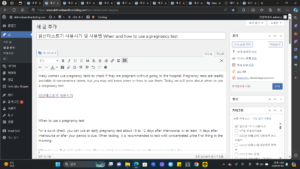Many women use pregnancy tests to check if they are pregnant without going to the hospital. Pregnancy tests are readily available at convenience stores, but you may not know when or how to use them. Today we will learn about when to use a pregnancy test.

When to use a pregnancy test
For a quick check, you can use an early pregnancy test about 10 to 12 days after intercourse, or at least 14 days after intercourse or after your period is due. When testing, it is recommended to test with concentrated urine first thing in the morning.
When to use: Test at least 2 weeks after your last sexual intercourse or after your period is due.
When to use: After waking up in the morning, urinate for the first time on an empty stomach.
A pregnancy test can tell you if you are pregnant about two weeks after ovulation, or usually about 10 days after fertilization, but because levels of the HCG hormone are low in the early stages of pregnancy, you should wait at least two weeks after your last sexual intercourse or after your scheduled period to get accurate results. It’s best. It is recommended to be tested early in the morning on an empty stomach because the hormones are most concentrated and the test results are most accurate. If you still suspect pregnancy and your hormone levels are low, it is recommended to retest with your first morning urine two days after the first test.
How to take a pregnancy test
The pregnancy test should be soaked in flowing urine up to the urine line for about 3 to 5 seconds, then placed on a flat surface and the results should be seen within 5 minutes. It is important to check the results within 5 minutes as errors may occur due to contact with air if time exceeds 5 minutes. Do not place the pregnancy test directly in the toilet.
To check your pregnancy test results:
● If both the control line (C) and test line (T) have two lines: positive (pregnancy).
● If there is only one line at baseline (C): negative (not pregnant).
● If both the baseline (C) and test line (T) do not appear, or only a single test line (T) appears: unmarked (retest required)
In the case of a positive test, if the vertical lines are clear, regardless of the darkness of the C and T lines, it is considered pregnancy. Even if there are two faint lines, the possibility of pregnancy is very high. If you visit the hospital after seeing two lines, a blood test or ultrasound will be done to confirm the exact pregnancy. However, if it is less than 5 weeks old, it may be difficult to confirm with ultrasound, so only a blood test is performed. As the pregnancy progresses, the concentration of HCG hormone increases and the color on the pregnancy test should darken, but if not, it may be an ectopic pregnancy and you should see a doctor.
I will tell you 5 foods that are easily digested by pregnant women.
After eating, you may feel bloated and have difficulty digesting food. In particular, it is caused by various factors such as hormonal changes and stress during pregnancy, resulting in imbalance. I stay healthy today
ningu9.tistory.com
Do not mistake implantation bleeding during pregnancy with menstruation.
When sperm and egg meet to form a fertilized egg, implantation bleeding occurs first. Therefore, if you do not confuse this, you can quickly find out about pregnancy. This is information that expectant mothers should know based on common sense.
ningu9.tistory.com
Pregnancy test error
Although pregnancy tests are very accurate (95-99%), errors can occur in rare cases. Errors may occur due to incorrect usage, but the test results may be inaccurate, such as a ‘false negative’ meaning that although you are pregnant, the level of pregnancy hormones is too high and the test line is blocked, meaning that you are not pregnant. Need to check.
If you do not see any test lines at all or only a test line, this may be a sign that you are using the device incorrectly or that there is a problem with the device itself and you should retest. If you do not have a period after a negative test, it is recommended to test again in about a week. Even if you are not pregnant, a positive response may occur after childbirth or miscarriage, or if you have taken hormonal treatments such as ovulation inducers.